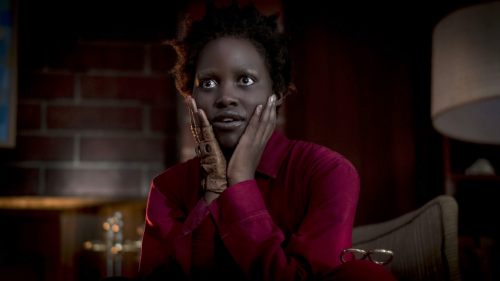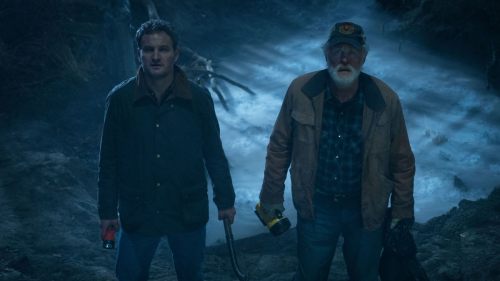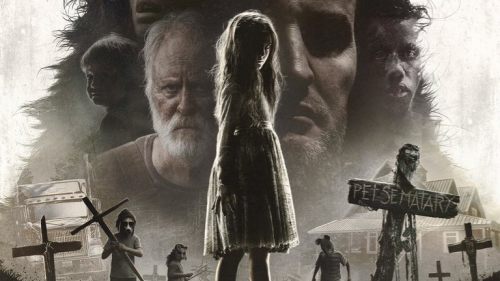The Cast And Directors Of PET SEMATARY On Stephen King, Grief, And Genre
Pet Sematary is out this week. Get your tickets here!
Stephen King’s 1983 novel, Pet Sematary, possesses all of the crowning ingredients of horror including relatable characters, visceral gore, universal emotions of grief, and elements of the supernatural. Directors Kevin Kölsch and Dennis Widmyer’s film adaption of the same name thrilled audiences at SXSW this year, proving classics are sometimes worth exhuming and bringing new blood to beloved films can create a killer reimaging.
Kölsch and Widmyer’s Pet Sematary mostly follows the same darkly paved path as the original. However, there is one big twist in the narrative that affects the nuclear Creed family. Louis Creed (Jason Clarke) is a doctor whose beliefs in life and death are clearly practical. It isn’t until his new neighbor Jud Crandall (John Lithgow) introduces him to a mysterious pet cemetery when his analytical perspectives become sourly obscured. Louis’ wife Rachel (Amy Seimetz) dotes on her two children Ellie and Gage after uprooting her own life to follow her husband to their new home in Ludlow, Maine. When Ellie passes away unexpectedly, the trauma of her death leads Louis down a slippery slope that has more sinister outcomes than he ever imagined.
In an age of perpetual King adaptations, Pet Sematary stands among the best. Despite deviating from the source material, Kölsch and Widmyer faithfully keep the bare bones of the book’s themes in place. “There are these great iconic elements from the book that we wanted to embrace. It’s a movie about grief, death, and all these really sad things, but at the same time there’s big horror elements here with the supernatural stuff and atmosphere,” Widmyer said. Jason Clarke read the book at least ten times and loves Stephen King. Clarke emphasized, “It’s one of my favorite novels by him. You can compare it to hopes and dreams, capitalism, and what would we really do if we could. King plays to a mass audience and is deceptively easy. He really draws you in.” In this respect, Kölsch and Widmyer do the same thing. Their approach to the storyline will easily adhere to the standards of die-hard King fans with hidden Easter Eggs throughout, highly stylized filmmaking, and special effects that lure viewers into the life of the Creed family, while the emotional impact is solidified with heavy-hitting performances courtesy of Clarke, Seimetz, and Jeté Laurence as Ellie.
In order to get into such a dark headspace, Clarke reiterated, “You have to ask yourself what if and what would you do if you lost a child? You’re a widower or a spinster if you lost a husband or wife, but there’s no word for what you are if you lost a child.” While the film heavily focuses on Louis’ grief and trying to keep his family together at all costs, Rachel’s grief process through the denial stage contrasts greatly from her husband’s. She becomes the more logical one and realizes the damage he’s inflicted upon them whereas Louis is buried in his own delusion. “From a maternal instinct, it’s not my daughter. Seeing Ellie, you just get broken and it defies the laws of reality. Approaching it as this creature that is hugging you, it doesn’t feel the same as your daughter”, Seimetz said. “The film follows a very logical, identifiable process of grieving from beginning to a certain point where it defies reality, then these two people are confronted with that. How do you show chaos in the brain and how do you let go of reasoning because you can’t reason anymore once you hit a certain threshold and can no longer use reason to compute?” Seimetz continued, as she discussed how her performance was influenced by Shelley Duvall’s character in The Shining and Isabelle Adjani in Possession. As Rachel, Seimetz successfully embodies what madness looks like in moments that defy logic. She adds a unique layer of terror that comes with being a parent, let alone one that loses their child.
Clarke described Ellie’s monstrous new traits as Louis’ responsibility. “If you do build it like in Frankenstein or The Bride of Frankenstein - you’re responsible for it. It’s not just that you build a monster, the monster is alive and it is yours to look after.” Therefore, Ellie personifies grief and regret as a literal monster that keeps coming back home to remind her parents of their mistakes. There’s a certain relatability and cathartic element to this concept in the horror genre which Pet Sematary executes extremely well. Grief is something all of us deal with at one point or another and the way we carry it, bring it back, and deal with it is ultimately our responsibility.
The all-encompassing effects of grief and dread are a part of what drew the directors the project. Referencing Don’t Look Now, the sense of dread was a priority and the directors utilize specific framing and shots to capture feelings of trepidation and isolation from the beginning. Kölsch revealed, “the camera pulling out in several scenes is an attempt to make people feel small in their environment. It’s a story where these people are at the hands of this greater nature that’s surrounding their house and this burial ground that’s beyond their understanding. You have so many personal stories of people who have this incredible loss and extreme close-ups with their grief because it’s the most important thing to them.” Kölsch elaborated that “it’s wrecking to this family, but then you kind of step back and realize each one of us is just a dot in the grand scheme of things in the end.”
Playing with the universal experiences of loss and grief while utilizing inventive technical styles to adhere to genre tropes, Pet Sematary is a visually stunning and emotional journey with bursts of dark comedy, violence, and gore along the way to really drive it home. Widmyer added, “We like to work practically, but we don’t shy away from computers being used for what they’re for. CG is a tool to enhance what you’re doing but the foundation should always be practical, especially when it’s performance based.” Almost all of the effects are practical, whether they be prosthetics used for Zelda’s distorted back piece or the slicing of Jud’s Achilles Tendon.
“The film tackles the grief you carry around really well and just the simple concept of letting go is not very simple”, Seimetz said. However, despite its dismal subject matter, Pet Sematary is still a fun movie to watch which speaks to the talent involved. Seimetz continued while describing her experience at the film’s SXSW premiere, “I love what you can get away with in genre, the stakes, and how cathartic it is to watch something and be able to laugh at pain. Genre fans are so fun, and they understand the joy of a group experience and interacting with the film.” Widmyer added, “[in horror], you really can have the best of both worlds - you can have a great Friday night movie that will thrill people where they laugh and have a good time, but hopefully it will stick with them and it will linger”. Pet Sematary is a prime example of a genre adaptation done right. It’s a reminder that we can have an entertaining balance of juxtaposition within a single story - classic and adaptation, life and death, love and loss, pain and pleasure.



